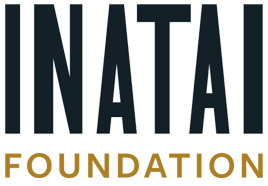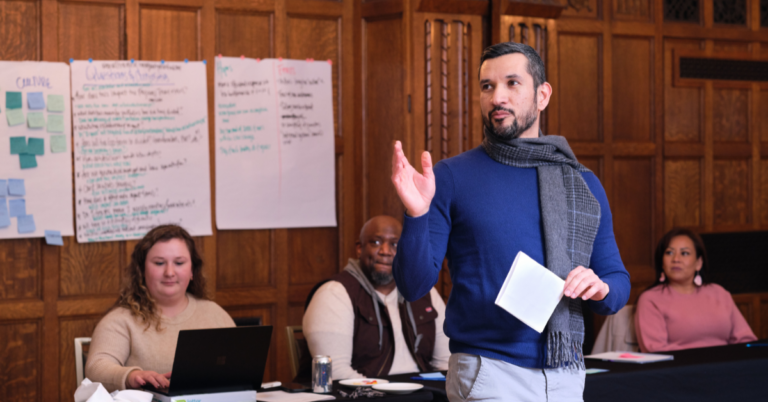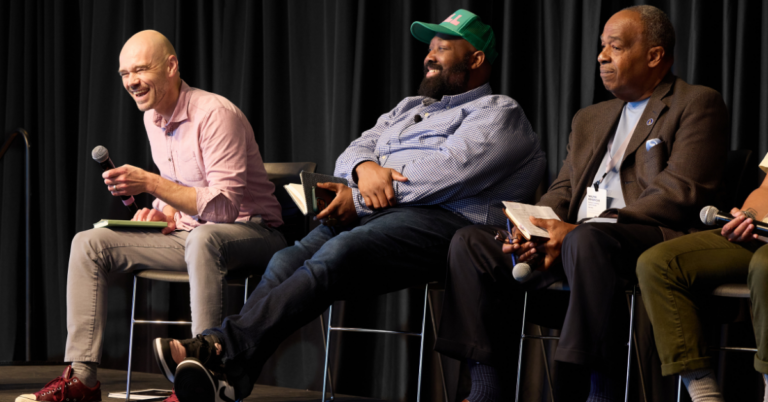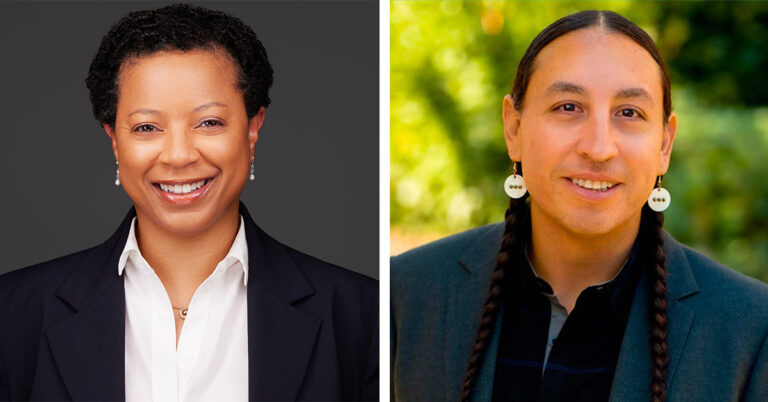Until Feb. 1, 2023, we were Group Health Foundation. This post was written under our former identity. To learn more about our new name, read our announcement here.
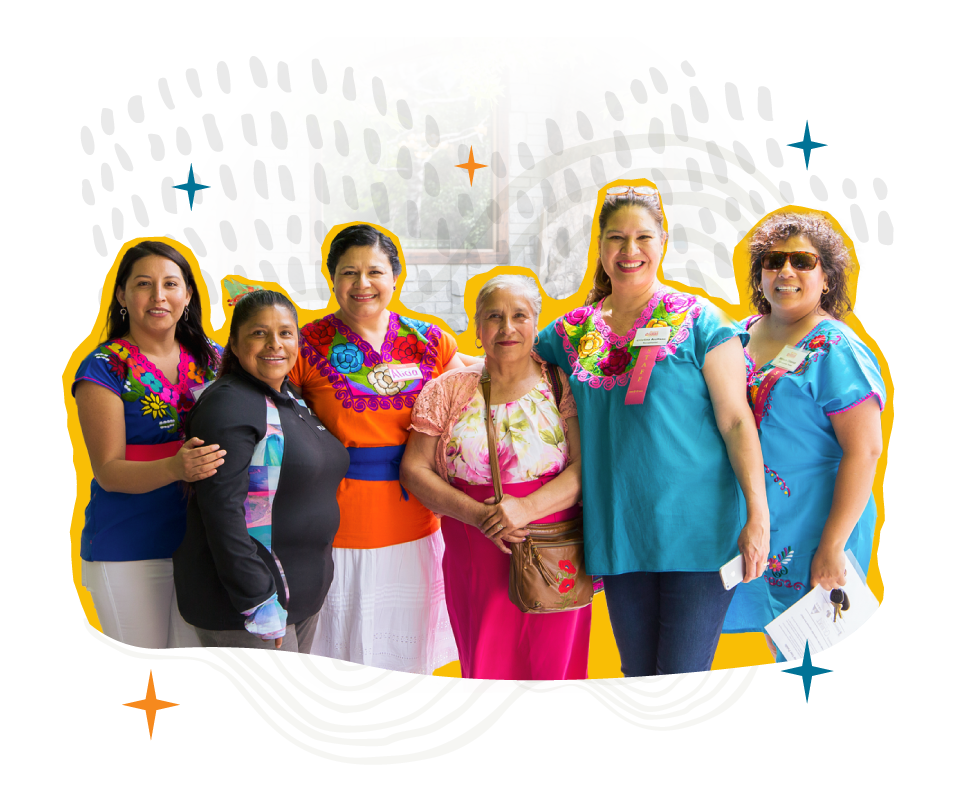
Magaly (far left) with La Casa Hogar colleagues, students, and volunteers at the Connecting Communities Fiesta. Photo: Magaly Solis
Magaly Solis recently became La Casa Hogar’s first Latina executive director in the organization’s 33-year history. Her hire was the result of a rigorous and intentional process designed to give greater decision-making power to those most impacted by the outcome: La Casa’s community volunteers, staff, and students.
An immigrant from Guerrero, Mexico who grew up in Mabton, Magaly graduated from Heritage University with an education degree. Few teaching opportunities were open to her because of her undocumented status, but one that was ended up being much more than a job. Eight years ago, she joined La Casa Hogar as a U.S. citizenship class instructor and has remained ever since. “During my time in the U.S., I really struggled to find community. I always felt kind of isolated. La Casa is where I found my people. It’s where I found community,” Magaly said.
La Casa Hogar partners with Latina immigrant families in the Yakima Valley to offer core education programs to connect them to their individual and collective power. In celebration of her new role, we spoke to Magaly about organizational transitions to people-of-color leadership, how philanthropy can support nonprofits like La Casa Hogar, and her favorite places in the Yakima Valley. La Casa Hogar is a Systems, Power, and Action grant recipient.
Q: How would you describe your community?
We are in an agricultural area, and we feel all the seasons: fall, summer, spring, now winter. You can definitely feel the flow of the work but also the energy that comes with each of the seasons. The seasons are also connected to our organization because you feel it right away when you’re offering classes in the evenings. Students have been working all day—some working more than 10-12 hours—and they still have the drive and the desire to come to class because they want to become U.S. citizens, get their GED, learn English, get a better job, or simply be able to help their children with their school work.
The people we work with are strong; they know what they want and what they need. And they’re also not afraid to come to an organization like La Casa and ask for the things they need. Many of our programs actually started that way, a student saying, “I want to become a citizen. There are no citizenship classes. Can you start citizenship classes here?” There’s a sense of community belonging and community leadership.
Q: The process that led to your hire included meaningful participation from community members and staff, instead of being led solely by a board of directors. What are some of your reflections on the process? And how does it feel to be selected by your community?
It was a long process; it was a year-long process. We had the vision, had conversations, brought people together, and collectively we created the steps that felt more aligned with our mission and values. And that is such a different—but better—way of doing things. Because when you don’t have a strict structure, there is flexibility to be able to create, change, or adapt your plan as you go. This transition process required a lot of learning but also unlearning of inequitable practices that had prevented a person of color from ever holding this leadership role in the organization.
There was key strategic work that also happened before we even started to talk about the transition. For many years our board was not representative of those we serve. Slowly, our board became more representative of our community, which also played a big role in having a successful transition. We had board members who were more willing to share their power and being led through the transition process rather than leading the process.
At other organizations, transition processes may look like hiring a consultant who develops a plan for the board to follow, an outsider coming in. I’m not saying there’s anything wrong with that—especially if that’s what works for the organization going through a transition. But here, we created a totally different process that really incorporated the voices of the people who were going to be most impacted by the decision. So that’s why it took us a long time.
On a personal level, it was a really vulnerable experience. During the interview process, there was one in English and another in Spanish. And I remember preparing for the English interview and thinking, “I need to think about something smart to say.” Then I had to stop myself and realize that that was coming from my internalized oppression. It was from my lived experience as an immigrant, always having to justify my existence and explain why I deserve an opportunity to do the work or sit at the table. I had to tell myself: This is the space where I can be myself. And that it is more than enough to just show up as I am in an authentic way.
Q: One in three people in Washington are people of color, and that number will only grow over the next few decades. You work in an area that’s majority people of color. What do you say in response to organizations who claim they cannot find any qualified people of color to lead their work?
First, out of curiosity, I would ask: “What do you mean by qualified?” Because their definition of qualified might be really different from my definition. Exploring that a bit more opens up an opportunity to have deeper conversations. It also allows us to talk about the impact of oppressive systems—how they function and how they prevent people of color from accessing opportunities to hold positions of power.
The other thing is if we’re talking about a white executive director leading an organization that mainly serves people of color, I would be curious about their level of awareness about the impact that occupying that space has on the people of color they lead and serve. Something I hear often from white leaders is: “I love what I do. I’m so passionate about the organization. And I will step down when the right person comes.” That mentality—that change happens just like that—removes them from their responsibility to be intentional, by looking at what needs to change internally to open space for people of color to rise to leadership positions. They just hope it will happen, you know, the right person of color will just arrive and say, “Here I am!” It doesn’t happen like that in a society with so many inequitable and racist systems that create so many barriers for people of color.
Also, sometimes when transitions happen, it’s when the ship is sinking, when an organization is not in a good place. That’s when we typically see women of color being offered the opportunity to step into leadership roles. Regardless of the support and their skill level, this is a disservice to women of color. So that’s another thing organizations looking to go through a similar transition as ours need to think about: When is the right time for the transition to set someone up for success? To ask a woman of color to step into this role when the organization is in bad shape is just not fair.
Q: What advice would you have for philanthropic organizations like ours? How would you like us to show up and be supportive of your work?
Be open, flexible and listen. With this whole transition, when the announcement was made, I started to receive a lot of really positive comments and also a lot of questions like, “What is the vision? What are you going to change?” I was even asked, “Who are you going let go, and who will you hire to support your vision?” Our process doesn’t just end with hiring a director of color. That is only the start.
I am not just new to the ED role, but I’m also succeeding a white person who was leading this work as a white person. We were doing work and following processes that worked for her, but it doesn’t necessarily work for me as a person of color. So, allowing for more transition time to have the ability to ask deeper questions about our work and our vision. How do we, as people of color leading an organization, want to show up to this work? How are we upholding inequitable practices and/or norms or behaviors? Doing this deep reflection and letting go of the things that no longer serve us will take time. The multiyear grant from Group Health is helpful because it is allowing us to have the financial stability to do the transition process right.
I would also add that the experience La Casa went through is not going to be the same at other places and organizations. If you try to replicate what we did, it might not be the same because you’re not in the same situation, the same political setting, or the same community. So as a philanthropic organization being open to listening, learning, and being responsive to the unique need of the organization is really important.
Q: What are some of your favorite places in the Yakima Valley?
OK, so I think the best Mexican food is in Toppenish and called Taqueria Mexicana—it is my favorite place to eat. If I am driving to the Lower Valley or when I’m on my way back from there, I have to stop there because I really like their food.
I also just really enjoy driving down the Lower Valley. When you pass Union Gap on the freeway, there is a section where you can see Mount Adams—or Pahto—its Native name. It makes me feel connected to the land. When we first came the U.S., we lived in Mabton and had a view of Pahto that was so beautiful. I used to tell my dad, “Take us there! I want to go to the mountain.” And my dad was like, “See that white stuff? That’s snow. We cannot go up there.” He said that because we come from a tropical town on the coast of Mexico. There are no mountains like that. It was new to us.
Years later, I met a friend who introduced me to mountaineering. So, I ended up summiting Mount Adams four times. And to go through that experience, knowing that I once wanted to explore it, getting to know this land, gave me—after 20 years of living in this country—a sense of place, a sense of home.

Magaly and her friend summiting Pahto. Photo: Magaly Solis
Keep in touch with La Casa Hogar by signing up for emails or following them on Facebook, Twitter, or Instagram.
